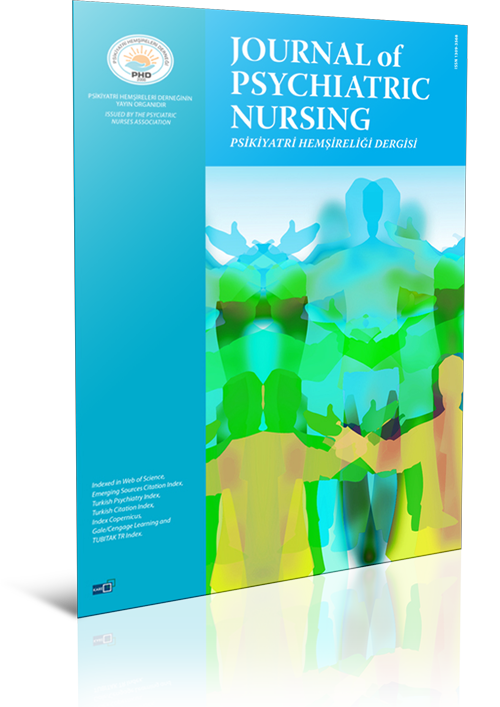
Volume: 11 Issue: 3 - 2020
| 1. | Frontmatter Pages I - III |
| EDITORIAL | |
| 2. | Editorial Gülsüm Ançel Page IV |
| RESEARCH ARTICLE | |
| 3. | Effect of guided imagery on the functionality of individuals diagnosed with schizophrenia in a community mental health center Özge Elgit, Ayşegül Bilge, Adem Bayrakçı doi: 10.14744/phd.2020.70707 Pages 165 - 172 INTRODUCTION: The aim of this study is to determine the effect that guided imagery has on the functionality of individuals diagnosed with schizophrenia in a community mental health center. METHODS: This is a pretest-posttest-controlled group study including 631 individuals registered in the Community Mental Health Center (CMHC) of Ege University Medical Faculty Hospital, of which 55 individuals were diagnosed with schizophrenia, as well as 300 individuals registered in the CMHC of Katip Çelebi University Atatürk Training and Research Hospital, of which 30 individuals were diagnosed with schizophrenia, and who were receiving continuous daytime service. The study sample included 48 individuals that fit the inclusion criteria among the 85 individuals who benefitted from daytime CMHC. The study was completed with 24 individuals in the experimental group and 24 individuals in control group. The value of power analysis is 98.8%. As data collection tools, an Introductory Information Form, Functional Remission of General Schizophrenia Scale (FROGS), and Subjective Recovery Assessment Scale (SubRAS) were used. For the numerical measurements, Mann-Whitney U test, Wilcoxon t test, one-way ANOVA test, and Chi-squared test were used. RESULTS: As a result of guided imagery applied to the study group 10 minutes daily for two weeks, a statistically significant difference was detected between the mean score of daily living skills subscale of FROGS (z=-2.69, p≤0.01); mean score of treatment subscale (z=-2.37, p=0.01); overall mean score of FROGS (z=-2.41, p=0.01); mean score of SubRAS (z=-3.70, p≤0.01). However, no significant difference could be found between the mean scores of social functioning subscale of FROGS (z=-1.80, p=0.07) and the mean scores of professional functioning in FROGS (z=-0.46, p=0.64). DISCUSSION AND CONCLUSION: According to the results of the study, it can be said that the guided imagery application for two weeks has created a significant difference in functional remission of the cases diagnosed with schizophrenia. |
| 4. | Determination of internalized stigma and social functioning level in schizophrenia patients Hasan Sevinik, Fatma Taş Arslan doi: 10.14744/phd.2020.50455 Pages 173 - 180 INTRODUCTION: This definitive-relational type of study determined the level of internalized stigma and social functioning and the factors that affect the level of internalized stigma in patients with a diagnosis of schizophrenia. METHODS: The sample population included 113 patients with a diagnosis of schizophrenic patients. A personal knowledge form, the Social Life Evaluation Questionnaire (SLEQ, independence-performance subscale of the Social Functioning Survey (SFS), the, and the Internalized stigma of Mental Illness (ISMI) scale were used to collect data. The data were collected between December 2015 and February 2016 in polyclinics and a center of community mental health of a hospital using the face-to-face technique. The data were summarized using number, percentage, average, and standard deviation. Because a normal distribution was determined, the independent t-test was used for pair-wise comparisons. For evaluating relationships among continuous variables, correlation analysis was used. RESULTS: In this study, education level and smoking status affected internalized stigma status. If patients met with their friends, relatives, or partner frequently or joined in social activities, the level of internalized stigma decreased. There was a weak and negative correlation between the independence-performance subscale of social functioning and total points, alienation, stereotype endorsement, social withdrawal, and stigma resistance subscales of internalized stigma in mental disorders. DISCUSSION AND CONCLUSION: Patients with schizophrenia have a medium level of internalized stigma. There is a relationship between the internalized stigma level with some sociodemographic features and social functioning situations. Psychiatry nurses should attempt to increase patient function in cooperation with institutions and the patients family. |
| 5. | The relationship between perceived family support and happiness level of patients with schizophrenia Fatih Şahin, Özlem Şahin Altun doi: 10.14744/phd.2020.09821 Pages 181 - 187 INTRODUCTION: This study was conducted to determine the relationship between perceived family support and the happiness level of patients with schizophrenia. METHODS: The study population included all the patients at the relevant polyclinic who were diagnosed with schizophrenia according to DSM-V diagnosis criteria and those who met the inclusion criteria. This study was completed with 137 patients; no sampling method was applied. Data were collected using a Sociodemographic Information Form, a Perceived Family Support Scale (PFSS) and a Subjective Happiness Scale (SHS). RESULTS: The patients mean total Perceived Family Support Scale score was 25.84±12.94. The mean total Subjective Happiness Scale score was 20.01±4.18. There was no statistically significant relationship, positive or negative, between the patients mean PFSS and SHS scores (p>0.05). DISCUSSION AND CONCLUSION: It was determined that family support had a significant effect on happiness, that there was a parallel relationship between family support and the patients happiness level, and that the happiness levels increased as the family support increased. |
| 6. | Vulnerable Baby Scale: A validity and reliability study Melike Yavaş Çelik, Zerrin Ciğdem doi: 10.14744/phd.2020.92678 Pages 188 - 194 |
| 7. | Investigating psychological distress level and its association with demographic characteristics in nurses Fatemeh Hatef, Azam Maleki, Korosh Amini, Esmail Khodadadi doi: 10.14744/phd.2020.99710 Pages 195 - 200 INTRODUCTION: Nursing is a highly stressful profession due to the long hours, workload, and extreme physical and psychological demands it places on individuals and their families. Research has shown that nurses, as compared to physicians, experience less social support and job security, and that their roles are not socially recognized. This study aimed to identify the level of distress by demographic characteristics of Iranian nurses working at various hospitals in Zanjan, Iran in 2019. METHODS: This descriptive correlational study targeted 264 nurses working at various hospitals in Zanjan, Iran in 2019. The random cluster sampling method was used for sample selection, and for data collection, a demographic and social characteristics form and the Kessler Psychological Distress Scale were used. Data were analyzed with SPSS statistical software (version 21), which was used to perform student's t-test and ANOVA. RESULTS: The results from calculation of the nurses mean score indicated that their psychological distress was at a moderate level (25.15±8.77). Gender, marital status and type of employment significantly corresponded with the nurses levels of psychological distress (p<0.05). Furthermore, there was a significant negative relationship between age and work experience with psychological distress among the nurses (p<0.05). DISCUSSION AND CONCLUSION: The findings derived from this study indicate that a majority of the nurses had some degree of psychological distress, which negatively affected the quality of health care they provided. Thus, appropriate steps, like in-service training for stress management, should be taken to ensure the psychological and physical health of Iranian nurses. |
| 8. | The relationships between university students physical activity levels, insomnia and psychological well-being İlkben Demirer, Saime Erol doi: 10.14744/phd.2020.46547 Pages 201 - 211 INTRODUCTION: This study aims to determine university students physical activity levels, insomnia and psychological well-being, and to examine the relationships between them. METHODS: This descriptive and correlation-seeking researchs sample included 702 voluntarily participating students studying in the faculty of health sciences and the faculty of science and letters at a university. The data were collected using a 23-item participant information form, the International Physical Activity Questionnaire (IPAQ), the Bergen Insomnia Scale (BIS) and the Psychological Well-being Scale (PWBS). Descriptive statistics, the Mann-Whitney U test, the Kruskal-Wallis test, the chi-squared test, logistic regression analysis and the Games-Howell post hoc test were used to evaluate the data. RESULTS: Of the students, 20.4% were inactive, 57% were minimally active, and 22.6% were sufficiently active. Of them, 59.3% had insomnia. The participants PWBS scores were above average (40.23±8.18). The students who described themselves as having a bad psychological state had more insomnia, and a one point increase in the PWBS score reduced the risk of insomnia by a factor of 0.972. The students with bad family relationships had increased risk of insomnia by a factor of 1.512, the students who had continual headaches had increased risk of insomnia by a factor of 2.504, and the students who used phones in bed had increased risk of insomnia by a factor of 1.760. DISCUSSION AND CONCLUSION: High physical activity levels increased psychological well-being, and high psychological well-being scores, good family relationships and regular physical activity reduced insomnia. |
| 9. | Investigation of eating behavior in adolescents in terms of family functionality Mehriban Günaydın, Hatice Kumcağız doi: 10.14744/phd.2020.45762 Pages 212 - 219 INTRODUCTION: The aim of this study is to examine eating habits in adolescents in terms of family functionality. METHODS: This study, which examines the eating habits of adolescents in terms of family functionality, is descriptive and relationship-seeking. The target population of this research consisted of 8,052 students who continued their education in the central district of the Turkish Giresun Province in the 20172018 academic year. The sample of the study was determined to be 385 to produce 95% reliability and 5% margin of error. In the research, a suitable non-random sampling method was used. An eating-attitude test, family assessment scale and Personal Information Form were used for data collection. In analyzing the data, frequencies and percentages were used to determine the socio-demographic characteristics of the students. The average of scores of the eating attitude test and family functionality was examined through one-way MANOVA analysis to see whether there is any difference according to the sociodemographic characteristics. The relationship of students' family functionality with eating attitudes was examined by simple linear regression analysis. RESULTS: Of the students participating in the study (average age 16.03 years), 206 (53.5%) were boys and 179 (46.5%) were girls. According to the analysis results, family functionality was found to predict eating attitudes (p<0.001), but no significant difference was found between the variables of gender, eating behavior, and perceived parental attitudes, and eating behavior and family functionality. No significant difference was found between the variables of gender, eating behavior and perceived parental attitudes, and eating behavior and family functionality. DISCUSSION AND CONCLUSION: This study found that there was a positive relationship between adolescents' family functionality scores and eating behavior scores, but there was no significant difference between adolescents' gender, eating behavior and perceived parental attitudes variables, and eating behavior and family functionality. |
| 10. | A validity and reliability study of the Turkish version of the Assessment of Survivor Concerns Scale Pınar Serçekuş Ak, Okan Vardar, Hatice Başkale doi: 10.14744/phd.2020.63308 Pages 220 - 227 INTRODUCTION: This study aims to test the validity and reliability of the Assessment of Survivor Concerns Scale (ASC) adapted to Turkish. METHODS: This research is a methodological study of 200 people. Data were collected from November to December 2018, through a social media account of a cancer-oriented association and those who had been diagnosed and treated for cancer for at least a year, at least primary school graduates and individuals over the age of 18 years. For validity analysis, language equivalence, scope validity, exploratory and confirmatory factor analysis were used. For reliability, internal consistency, item-area and test-retest were used. Data were analyzed with SPSS V22.0 and LISREL 8.8 programs. RESULTS: According to the exploratory factor analysis; the factor loads of the scale items and the total variance explained were sufficient, according to the confirmatory factor analysis the fit indexes were found to be at a desired level. For the reliability analysis; Cronbachs alpha internal consistency coefficient was highly reliable, each item represented the scale, according to item total score correlations each item was strongly or very strongly related to the scale and four weeks later the re-test given to the 50 survivors was found to be highly reliable. DISCUSSION AND CONCLUSION: The Assessment of Survivor Concerns Scale has been determined to be a suitable and valid-reliable measurement tool for use in Turkish society. |
| 11. | Relationship between perceived stress level and self-perception level of women who had three or more pregnancies Esra Demir Alkin, Kerime Derya Beydağ doi: 10.14744/phd.2020.72621 Pages 228 - 238 INTRODUCTION: The present study determined the relationship between the perceived stress level of women who had three or more pregnancies and their self-perception levels. METHODS: This descriptive and cross-sectional study was carried out with 230 pregnant women who had three or more pregnancies and visited the Gynecology and Obstetrics Polyclinics of Kocaeli University Research and Application Hospital between May and October 2018. The data collection was performed using the personal information form, Self-Perception Scale for Pregnant Women and Perceived Stress Scale (PSS). In analyzing the data obtained, the percentages, t-test, ANOVA test, Mann-Whitney U test, Kruskal-Wallis test, and Spearmans Correlation Analysis were used. RESULTS: The mean score of the pregnant women on the PSS was 42.62±5.01 and the mean scores on the Perception of Motherhood during Pregnancy (PMDP) and Perception of Body during Pregnancy (PBDP) subscales were 19.54±5.07 and 13.16±3.96, respectively. A weak negative relationship was found between PSS and PMDP (p<0.05), whereas no relationship was found for PBDP (p>0.05). PMDP and PBDP had a weak negative relationship (p<0.05). DISCUSSION AND CONCLUSION: The perceived stress level of women having a history of three or more pregnancies affected their motherhood perception but not their body perception. |
| SYSTEMATIC REVIEW | |
| 12. | The use of animal-assisted practices as a nursing intervention: A systematic review Şeyma Demiralay, İlkay Keser, Sibel Çaynak doi: 10.14744/phd.2020.82474 Pages 239 - 250 INTRODUCTION: The Nursing Interventions Classification is used for planning nursing care. Animal-assisted practices, an intervention within this classification, is a treatment method that is widely used around the world. However, its use is limited in Turkey. Animal-assisted practices, which are used to support various groups today, constitute an intervention option in addition to medical treatments, ensuring health protection and promotion. This systematic review aims to analyze the randomized controlled studies that used animal-assisted practices and to determine the effects of this procedure and the interventions made, thereby contributing to the literature. METHODS: The databases on this subject were analyzed without any limitations on the publication year, and a total of 1,985 studies were accessed. The search was made using the keywords animal assisted therapy, animal assisted therapies, pet therapy, pet therapies, and nursing in the CINAHL, Cochrane Central, Medline/Pubmed, Web of Science, and Science Direct; and the keywords hayvan destekli uygulama, hayvan destekli terapi, and hemşirelik in the electronic databases of the National Thesis Center of the Council of Higher Education and the ULAKBIM. Six randomized controlled studies that met the inclusion criteria were included in the study. These six studies were evaluated in terms of the characteristics of their samples, the animals used, the place of the practice, the measurement tools, and their results. RESULTS: All studies were conducted in the last six years. In the randomized controlled studies, the sample comprised 66.66% old people, 16.67% adults, and 16.67% adolescents. The studies were conducted in elderly care centers (33.33%), hospitals (33.33%), elderly day care center (16.67%), and healthcare centers and hospitals (16.67%); they used dogs (as live animal), robotic pets, and humanoid robots within the scope of the intervention programs. They used different measurement tools to evaluate the effectiveness of the intervention. Animal-assisted practices were found to reduce stress and the use of analgesics, positively affect vital signs, support other treatments for mental diseases, and increase self-esteem, social interaction, and quality of life. DISCUSSION AND CONCLUSION: The results of this study showed that animal-assisted practices were an effective nursing intervention. However, it was found that randomized controlled studies indicating the effectiveness of animal-assisted practices were limited, and that no studies have been conducted in Turkey on this subject. It is suggested that studies should be conducted which use animal-assisted treatment as a nursing intervention, the results of which would further contribute to the literature. It is recommended that animal-assisted practices should be included more in nursing studies. |
| REVIEW | |
| 13. | De-escalation model in the simple form as aggression management in psychiatric services* Didem Ayhan, Duygu Hicdurmaz doi: 10.14744/phd.2020.80488 Pages 251 - 259 Aggression management in psychiatric wards has been a difficult but important issue. Classical methods that have been used in aggression management in the past have a repressive-compelling nature and can cause emotional / physical harm. This has led to the emergence of alternative methods that provide flexibility for the management of aggression. Alternative methods consider the patient's feelings and what is wanted to be expressed. It recommends working with the patient to solve the problem, and in this way aims to reduce the potential harm to patients and health workers. In this article, the de-escalation model in the simple form, developed by Len Bowers (2014) as one of the alternative de-escalation methods, is explained. This model is thought to be a guide for clinical psychiatric nurses in creating a therapeutic environment focused on preventing aggression in psychiatric wards due to its ease of application, low cost, and solution-oriented approach. |


















